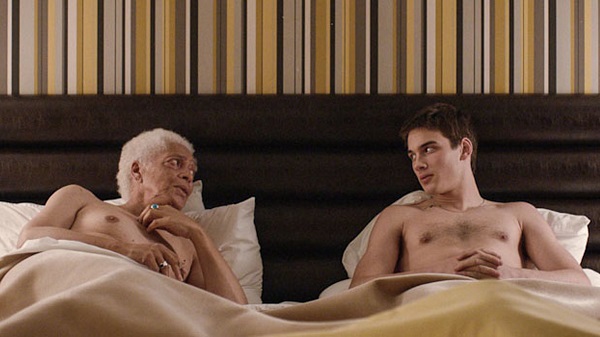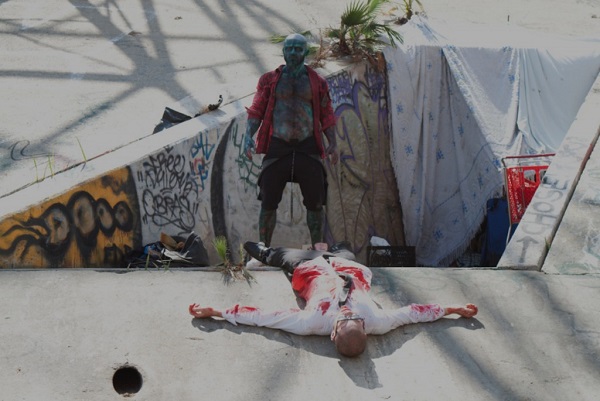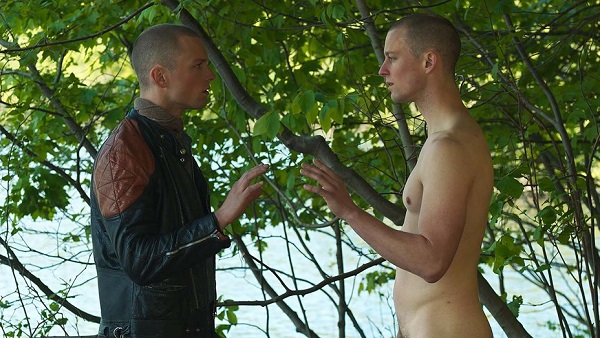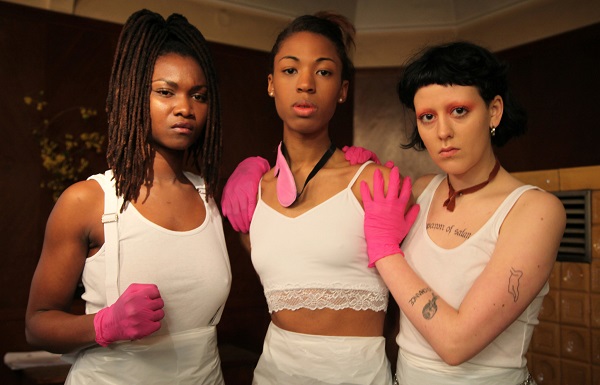
Bruce LaBruce may just be the last true punk left in Canada. Ever since bursting on to the Toronto underground scene in the late ‘80s, the queer-core legend has been sticking his middle finger in the face of conventional society through his work in film, porn, journalism, photography, opera or whatever other artistic endeavor he tackles. While some of his peers have softened or sold out, the man behind subversive masterpieces like No Skin Off My Ass and Hustler White has always remained defiantly on the fringes of Canadian film culture.
And even during a global pandemic, LaBruce shows no signs of slowing down. His latest film is Saint-Narcisse, a modern retelling of the Narcissus myth in which a vain young man (Félix-Antoine Duval) goes on a journey to find his birth mother, taking him to a rural village where she lives in a cabin with a fiery young woman. Then, to confuse things further, he spots a young monk at a nearby monastery who is his exact double, leading him to question his entire state of being. With this setup, LaBruce busts through taboos of incest and religious perversion with glee, resulting in an experience that is as charming and emotionally resonant as it is transgressive.
Currently on its festival run, we sat down with LaBruce to discuss Saint-Narcisse, his career and what it means to buck the system in 2020.
In The Seats – I’ll start off with the question that every filmmaker with new work right now is being asked. What’s it like premiering a new film in the midst of a pandemic? How’s the festival scene or lack of it?
Bruce LaBruce – It a drag, to be honest. The film was finished and we were halfway through post-production when the lockdown happened. We had to go on hiatus for two months but then in May and June we came back to finish it in post and had it done in time for Venice. In some ways we were incredibly lucky since Venice was the first festival that opened up a little bit since there was a lull in COVID numbers at the beginning of September. Even though it was complicated, me and my producer and the star of the film, Félix-Antoine, all went to Venice and there was a proper screening for the world premiere, with distanced audience and masks. So instead of like 900 people, there was like 350-400 people. I have a history with the Venice Film Festival – my film Gerontophilia premiered there and I was the president of the jury of Venice Days in 2016. But it was kind of weirdly deserted. There were no Americans there at all…
ITS – Maybe that’s a good thing…
BLB – Well, the first night we had dinner and because the numbers were so low, the restaurants were all open, mostly outdoors. It was beautiful, it was 28 degrees and it was all al fresco dining. And right at the table next to us was Matt Dillon. So we thought, oh here’s someone from North America. But apparently he has a girlfriend that lives in Rome so he had just been staying there.
ITS – So that doesn’t really count.
BLB – Yeah exactly. And we were also the only fully-financed Canadian film there so the Canadian Ambassador to Italy came to our premiere from Rome and partied with us. Félix-Antoine is a TV star in Quebec but he’s never been in a feature film or at a major festival so I was really glad that he had that kind of glamourous experience and to see it on the big screen for the premiere. That was really special.
We had hoped to do the same thing when it premiered in Quebec at the Festival du nouveau cinéma but unfortunately it went virtual. It played at Sitges and it was an actual screening but I couldn’t go because of COVID. It’s playing at Busan in a couple of days so it is getting around. It’s kind of a mixed blessing in a way because there’s not that many films coming out. At least we weren’t interrupted during production.
ITS – I always thought the festival experience was really important for your films. I remember seeing L.A. Zombie at TIFF a decade or so ago and seeing the mix of people who were hardcore fans of yours and then people who maybe thought they were just going to see a horror movie and those reactions.
BLB – Yeah, the festival experience has been really crucial for me as my films don’t often get wide distribution. Sometimes, in certain countries, it’s the only chance people get to have to see it on the screen. I’ve used the festival circuit as an opportunity to travel too. Back in the day, with Hustler White or The Raspberry Reich, I would spend a year and a half or two years on the festival circuit just travelling around all over the place. Also what I really miss is that I often get invited to smaller queer film festivals in unexpected places – last year I went to Lima, Peru and Santiago, Chile and Belgrade, Serbia which are kind of my favorites because in those countries, the queer scenes are still nascent. They’re still developing and there’s still a lot of queer liberation style energy which is exciting.
ITS – Focusing on Saint-Narcisse and specifically on your lead, Félix – he has such a striking look for this film, as a lot of your actors do. What were you looking for in your cast here?
BLB – I mean, way back at the beginning when the working title for this was “Twincest”, I wanted to cast real twins. But as the script developed and we got a pretty good chunk of money for it, I realized it would be hard to find twins that would not only be able to handle it dramatically but would also be intimate with each other on screen. So we did the body double thing.
The Quebec film industry is very incestuous – everyone knows everyone – so the screenwriter I cowrote this with, Martin Girard, his boyfriend was the casting director, Maxime Giroux. Maxime knew Félix very well and so he not only had him come in for an audition but also nudged me in that direction. But he didn’t really have to because I was looking for a particular kind of classical look and he has that timeless look that could be anywhere from ancient Greek or Roman to the ‘70s. And because it’s a retelling of the Narcissus myth, I had to cast a dreamboat. On the other hand, what impressed me was his openness to the idea – I mean, he’s straight-identified – how open he was to exploring the themes and how generous he was with showing his body. His scenes with the body double, who is gay, were very intimate and so he was very open to that. And he really threw himself into creating the two twin characters as well.
ITS – He makes a lot of distinctions between the characters to the point where I honestly thought it was two separate actors at first because I wasn’t aware of the film’s casting.
BLB – Yeah, some people have said that. And he did everything from taking motorcycle lessons to getting a dialect coach and an acting coach to help him develop the two characters. We also tried to keep the special effects kind of old school and used minimal digital effects. We only used six or eight replacement shots and the rest was either split screen or body double so I think that contributes to the illusion that it’s two separate people.
ITS – Your actors are also perfectly attuned to the camp aspect of the film and certain line readings. Do you look for a particular style of acting that is a little more self-aware?
BLB – I mean, the film is a melodrama in that classical Hollywood melodrama way. I think there are parts that are dramatically moving, that are played straight, which is even harder to do. It’s easy to camp something up in an obvious way but the key was for them to play it as straight as they could with an underlying self-awareness. But that’s built into the script too – some of the lines are pretty over-the-top. Not only the joke lines but even lines like Beatrice (Tania Kontoyanni) saying, “I always thought I was carrying twins but that night I buried the thought deep inside of me. The thought of losing both of you was unbearable.” It’s classic over-the-top melodrama but she delivered with emotion. That’s the key to good camp, I think – to play it as straight as you can.
ITS – The religious themes and iconography in this follow on from what you were doing in your prior feature, The Misandrists. I know you’ve said you like to queer certain ideologies and tropes from genre films but what’s been drawing you to religious themes in particular as of late?
BLB –The Misandrists was a nun-sploitation film and so this is kind of the more masculine version of that. It’s been something I’ve been exploring for a while. In 2012, I had this photo exhibit in Spain called “Obscenity”. I shot a lot of well-known Spanish celebrities and the theme of the show was the intersection of sexual and religious ecstasy. I used the ostia, the holy wafer, as a symbol of both censorship and eroticism with women wearing it as pasties or whatever. So that was when I really started exploring that theme and it stuck with me. A lot of my films have it – even Gerontophilia plays with the idea of Lake, the young boy, being a saint. I have a couple of scripts now that are based on saint characters. Even François Sagat in L.A. Zombie is like a saint because he resurrects people… by fucking them.
I just wrote something for someone in Mexico about Pasolini, who’s always been a huge influence on me, and how he combines secular philosophy and Marxism and a true Catholic devotion, or at least a religiosity, in all his films. For me, my films are quite often about fetish and the idea of fetish is very religious – there’s a devotion and a kind of devout appreciation of the fetish and the object of desire. If you look at Catholicism and the history of the saints, religious devotion is very sexual. The saints have the most perverse fetishes, whether it be kissing Jesus’s feet or washing his feet with their hair. Or like Ken Russell’s The Devils which was another inspiration I was thinking about. I think religious and sexual ecstasy come from the same place. They both become transcendent.
ITS – Narcissism obviously plays a large role in this film and it’s hard not to relate it to social media, where you’re constantly reflecting images of yourself back to yourself. Was that aspect on your mind at all?
BLB – The film really is a cheeky updating of the Narcissus myth. In earlier versions of the script it was more pronounced. I had other characters from the myth like Echo and a boy who was obsessed with Narcissus. The only one who kind of made the cut was Tiresias, the oracle, and that’s the transgender [sex worker] who warns him not to know himself. I mean, there’s the obvious line where Irene (Alexandra Petrachuk) says, “He only takes pictures of himself. Who does that?” I considered cutting it out because it was too on-the-nose but it does draw a direct allusion to everything that’s going on today, And it makes you think, yeah, that is fucking weird. Because back then, you would have been considered mad, absolutely mad, if you were walking around with a mirror looking at yourself all the time and taking pictures of yourself. And Félix’s character in the movie, Dominic, is even handing his Polaroids out to strangers just like you would now send a photo of yourself to a random stranger on social media. I mean, the ad line of the film is “Love thyself”, but you can take it too far. The kind of narcissism on display in social media now is clearly demented – the super self-objectification is crazy.
It’s complicated though because it’s built into the twincest theme, which is the most socially acceptable incest taboo because people can kind of wrap their minds around it. If you had someone who looked identical to you sitting beside you and if you actually have this strong psychic relationship with them, it’s kind of inevitable that there would be a sexual connection there. It’s even a subgenre of porn. But I was just pushing to see how far can you go with transcending these taboos before people start throwing up.
ITS – You often deal in taboos and I feel like your films therefore get labelled politically incorrect. But since political incorrectness has been more or less co-opted by the conservative right these days for regressive means, your brand of political incorrectness, on the other hand, always seems to be for more progressive and inclusive ends.
BLB – Well, I think you’re right that it’s now the provenance of the right more than the left. It used to be that people on the left were labelled politically incorrect for going against certain conventions or conservatism within the left. And now the right uses it – and Trump is the master of it, obviously – as a cudgel against the left.
My films are quite often a critique of the left and leftist radicalism. But for me, it’s an affectionate critique that still supports certain leftist tendencies like sexual radicalism or anarcho-syndicalist policies or whatever. As time goes on, I find it more and more difficult to identify in any sort of object way with the left. But I’m certainly not on the right so I’ve been calling myself a radical pragmatist, whatever that means.
It’s not difficult to be politically incorrect on the left right now because you have all these prohibitions, you have all these rules, you have conduct, speech is censored, there’s policing of sexuality. There’s the phenomenon of the circular firing squad. People are cancelled for, in some cases, minor offences, even though they’re strong voices on the left that are doing a lot of good. I guess my films have always been politically incorrect because certain segments of the gay world don’t think that I present gay to them in a positive light. I’m a bad gay basically.
ITS – I remember you caught some flack from critics over The Misandrists…
BLB – I expected more, actually. It kind of split the lesbian audience. A lot of them loved it because the film does in a way celebrate radical feminist lesbian separatists. You know, they’re really into that revolutionary idea of completely turning the tables on men. And I’m all for the idea of women taking over for a while since men have mentally screwed up everything. So I think they sense that in my films – it’s not coming from a misogynist place even though there’s tons of gay misogyny out there.
ITS – What’s your relationship like with Canadian film culture these days? You’ve always been an outsider and when you were shooting films exclusively in Germany, you didn’t seem to care about any sort of funding from homegrown organizations. With Saint-Narcisse, however, you’ve got support from Telefilm and CBC. Are you being embraced more by Canadian film bodies nowadays and does that feel weird to you?
BLB – It’s just Quebec. Only Quebec. I mean, I did have a couple of avant-garde films that were supported by the Canada Council and Ontario Arts Council. But in terms of Ontario Telefilm, they rejected three of my scripts – and when they rejected Gerontophilia, their excuses were pretty lame for not supporting it. That’s when I went to Quebec. We found a great ally and producer in Nicolas Comeau who knows the industry very well. So I was embraced by them for making films that are more challenging and maybe less commercial in their eyes.
But there’s not many filmmakers whose films go as far internationally as mine, even if the box office isn’t really there. But it shouldn’t always be about the money – it should be about making challenging work. The Quebec industry is influenced by European art cinema and more open to that kind of filmmaking. You know, I just go where the money is and because I’m not a nationalist, I can go anywhere. I have an upcoming project that is more of a Mexican-German coproduction.
In terms of being accepted in Canada though, I will say that even TIFF kind of rejected Saint-Narcisse…
ITS – Yeah, I saw that it only played as part of the Industry digital selection, which was strange to me.
BLB – Well, they said if it was any other year, blah, blah, blah… But then they added it to the industry screenings so at least it got some visibility. Usually, my films go around the world and then play in Canada but this time it’s different. Raven Banner picked it up and it’s played at least six Canadian festivals already. And because there’s CBC money in it, it may even be broadcast on their networks or it could be on Gem. So it has distribution in Canada which is kind of rare for me.
ITS – Is there any culture left in Toronto?
BLB – No.
ITS – Do you lament what Toronto once was?
BLB – This has always been my home base, even though I’ve lived in L.A. and Berlin. Part of the problem is that it’s driving out all the artists and musicians because they can’t afford an apartment. All the venues are being closed down. So yeah, Toronto’s a bit dire now. I find it’s a good place to stay and work. I used to spend all my time in New York as well in the ‘90s and then it started changing in the same way.
But I’m also at an age where I don’t need to be going out every day. Probably until I was 45, I would go out five or six nights a week and party a lot and be social, which is where a lot of creative energy came, hanging out with other artists and musicians. Now I’m older and don’t have to have that kind of constant connection with people all the time. Also because of social media I’m so connected with friends and colleagues and creative collaborators all over the world on a daily basis.
But Toronto is a sad case – it’s trying so hard to be progressive. I mean, even just the architecture and design of the city is so pathetic. It’s like a squandered opportunity. It could have been such a special, modern city and it’s just not.
ITS – You obviously have a love for cinema from the ‘60s and ‘70s, particularly European filmmakers. Is there anything that’s inspiring you in the current film landscape?
BLB – There’s a lot of great queer underground film and alternative porn. I’ve made some films for Erika Lust, which is this great porn company from Barcelona doing feminist and really interesting queer porn with higher production values. So there’s that – the queer, more alternative films today.
And then… mainstream Hollywood… you know, I don’t have much of a connection with anymore. I think it’s all real estate porn and it’s mostly about rich people and their boats… things like that. Like fucking Tenet – not only is it unnecessarily convoluted but it’s the worst kind of landscape porn. But you know, every once in a while there’s something I like. I actually liked 1917.
I’m getting burned out on all the TV series right now. I find them so formulaic. I was just looking at a bunch of trailers for Netflix’s most popular shows and it astonishes me how monolithic it is, both thematically and stylistically. It’s always about the same themes and it always has the same drone shots and the same bad CGI, same people walking in slow motion. It’s such a univocal aesthetic and formula. It’s really anti-cinema, I think. And it’s not really a directed medium either – the director is just kind of there to babysit the actors. There are some good shows that I watch but these days, I often lose interest after the second season.
In terms of cinema, there’s still European art cinema that I enjoy. I always like what von Trier is doing, which you either love or hate, or love and hate, but at least he’s doing something. And there’s Lanthimos – I’m not really a big fan of him but you have to be at least impressed by what he’s doing. And then there are a lot of great female filmmakers coming up as well. And in Canada, all the First Nations films now being made and finally recognized. And then you know, there’s people that I’m friends with like Gaspar Noé and Harmony Korine. I’m always looking forward to their films.
So yeah, I don’t think cinema’s quite dead yet.
ITS – Do you find there to be greater freedom in porn?
BLB – The freedom I enjoy is being able to go back and forth between films that are somewhat more accessible and distributable and films that are strictly porn. In some ways, I make porn between features to stay in practice as a filmmaker. And especially because the companies I work for make high-end porn, you’re still working with professional crews and shooting in that kind of style. Because you’re not given many restrictions, it’s a good place to experiment and play with themes you may not be able to play with in the mainstream.
ITS – Last question. Any plans for re-releases of your first two landmark underground features, No Skin Off My Ass and Super 8 ½, since they’ve been out of circulation for so long? I remember renting a video tape of No Skin Off My Ass from Suspect Video in Toronto (rest in peace) years back that they had said you personally donated to them.
BLB – Yes, I did. Part of the problem with those two films was that I never got music rights for either of them, making them a little difficult to distribute. A distributor in France a few years ago put out a box set of my first three films and every once in a while somebody will put out a box set in a different region. But you know, I don’t really mind that they’re inaccessible, to be honest. I kind of miss the idea of the underground. I think it’s better to be underground and not be able to find something than to have your movie sitting in a bargain bin and ending up like some disposable piece of trash selling for 50 cents. There’s a certain romance to the unavailability.
ITS – It does kind of add to the mystique of it. I was always fascinating by the fact that Kurt Cobain said No Skin Off My Ass was his favorite film of all time. Is that actually true or was that blown out of proportion?
BLB – I think that’s been a little exaggerated. He definitely watched it when it came out and said that he loved it, though. I know that.









